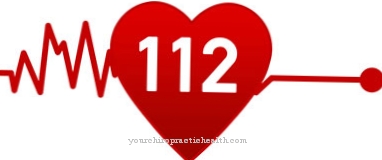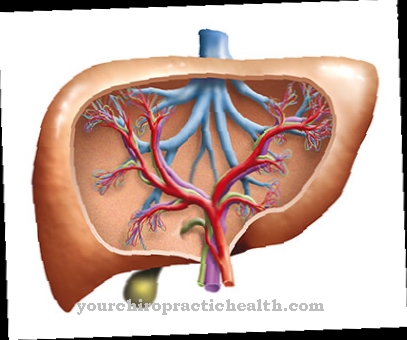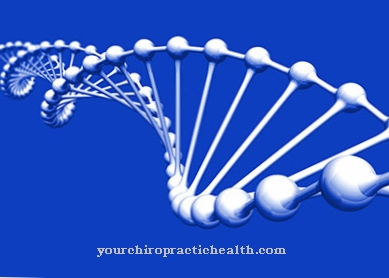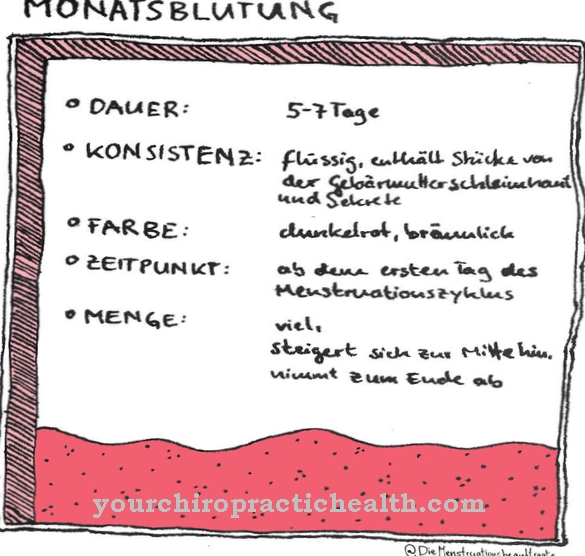Under a Cervical spine fracture or one Cervical spine fracture the medical professional understands the complete or partial vertebral fracture of the cervical spine. The is colloquial Cervical vertebrae fracture often also as Broken neck designated. This injury carries the risk of paraplegia if the spinal cord of the cervical spine is also affected. The therapy depends on the severity and type of fracture.
What is a cervical spine fracture?

© htpix - stock.adobe.com
The cervical spine, or cervical spine for short, is defined as the seven vertebrae of humans and mammals that lie between the head and thoracic spine. Injuries and fractures of the cervical spine are more common in children and the elderly.
All the nerve tracts that connect the body and the brain run through the cervical spine, so that a fracture in this area can have numerous consequences and symptoms. The typical symptoms of a cervical spine fracture are pain in the affected area, both at rest and when moving, poor posture of the head and the subjective feeling of the person concerned that he can no longer hold his head.
If nerve tracts have been damaged by the vertebral fracture, additional sensory deficits and paralysis occur, for example respiratory or circulatory arrest or paraplegia.
causes
The possible causes of the Cervical fracture a distinction must be made according to whether the person concerned belongs to a special risk group. In older people, even small acts of violence such as falls can lead to a cervical spine fracture.
In small children and infants, the neck muscles are too weak to hold the large head stable, so that even slight violence can lead to fractures of the cervical spine. Serious traffic accidents with frontal or rear-end collisions also lead to cervical spine injuries more frequently in older people and children.
If the person concerned does not belong to a risk group, the causes of a cervical spine fracture are overstretching or overstretching of the cervical spine, as can occur with direct or indirect violence. Bicycle and motorcycle accidents, accidents in contact sports and equestrian sports, and careless head jumps into unknown waters or from too great a height are often the cause of a cervical spine fracture.
Symptoms, ailments & signs
A cervical spine fracture is a dangerous injury that can be fatal under certain circumstances. Headache and neck pain are observed as typical symptoms. In addition, turning the head is difficult. This leads to unbearable pain and dizziness.
Furthermore, paralysis in both arms or only in one arm is possible. Often the head can no longer be held upright, so some patients even try to support it with their hands. The cervical vertebrae can shift against each other under certain circumstances. This is particularly common with unstable fractures. In addition, if fragments of bone get into the spinal canal, further damage to the vertebral bodies can occur.
In addition, bleeding into the spinal canal or the spinal cord is often observed. A cervical spine fracture is often accompanied by difficulty swallowing and bruises. The respiratory function is also impaired from time to time. This is especially true if the fourth cervical vertebra is affected. Paraplegia is one of the worst consequences of a cervical spine fracture.
Furthermore, respiratory and circulatory arrest is also possible, which leads to death. A cervical spine fracture can also be present in the case of whiplash. In addition to headache and neck pain, it is often characterized by paresthesia in the extremities, weakening of the reflexes, dizziness and hearing disorders. If left untreated, a cervical spine fracture often leads to severe disability or even death. Depending on the nature of the injury, full healing can occur with timely treatment.
Diagnosis & course
If a cervical spine fracture is suspected after violent action on the cervical spine, the doctor first conducts a physical examination. As part of this careful diagnosis of mobility and pain in the cervical vertebrae, nerve function is also checked.
The examination takes place while avoiding major stresses on the cervical spine. Since a manual examination can only corroborate the suspicion of a cervical spine fracture, not confirm or exclude it, a radiological diagnosis must be carried out afterwards. As a rule, an X-ray examination from the front and the side is sufficient for this. The X-ray image is meaningful and can be created quickly, so X-ray is the first choice diagnostic method.
In order to dispel doubts about the diagnosis or to clarify further questions, such as the exact course of the break or damage to the nerve tract, images can also be made with a computer tomograph (CT) or magnetic resonance tomograph (MRT). The prognosis and course of a cervical spine fracture must be assessed individually based on the exact form of injury and the affected nerve tracts.
Complications
The symptoms of a cervical spine hernia usually depend on the severity of the hernia. In the worst case, the person affected suffers from so-called paraplegia and is extremely limited in his everyday life. This leads to considerable restrictions in movement, so that the patient may be dependent on a wheelchair and other people in their everyday life.
The quality of life is extremely reduced by the cervical spine fracture. Furthermore, there are various paralyzes on the body and pain in the affected regions. The sudden paralysis and pain often lead to psychological complaints or depression. The patients also suffer from insomnia and this makes it difficult for them to ingest fluids and food.
As a rule, severe pain also complicates everyday life, which can also lead to sleep problems at night in the form of resting pain. Not infrequently, thoughts of suicide also arise. Whether treatment is possible for a cervical spine hernia depends to a large extent on the severity of the hernia.
However, a positive course of the disease cannot be guaranteed. In some cases, those affected are dependent on a wheelchair and other aids in everyday life for the rest of their lives. However, life expectancy is not affected by the cervical spine fracture.
When should you go to the doctor?
As a cervical spine fracture can, in the worst case, lead to paraplegia that can no longer be treated, a doctor should always be consulted. Since the cervical spine hernia is usually caused by an accident, the person affected is admitted to hospital. Otherwise, the patient should consult a doctor if there is severe pain in the cervical vertebrae or the spine.
Significant restrictions on movement also occur. Furthermore, a bruise indicates a cervical spine fracture, this is accompanied by swallowing disorders. Ordinary consumption of food and liquids is no longer possible for the patient. A doctor should also be consulted if the cervical spine fracture leads to paralysis or numbness. The earlier these are diagnosed, the higher the chances of a positive course of the disease.
The cervical spine hernia should usually always be treated in a hospital or by an emergency doctor. After the fracture has been treated, patients often rely on various exercises and therapies to reduce paralysis and restore mobility.
Doctors & therapists in your area
Treatment & Therapy
It is important to move the patient as little as possible. The head must be pulled evenly so that it is held in a slight backward bend. The injured person should be transported in a supine position wearing a neck brace (cervical brace).
The treatment of the cervical spine hernia also depends on the exact type of injury and consists primarily of protecting and immobilizing the affected vertebral area. In addition to immobilization with a cast, there are various types of cervical braces available that have to be worn for eight to twelve weeks. Conservative therapy may only be initiated if the disc between the 2nd and 3rd cervical vertebrae is intact. Then the doctor speaks of a stable injury.
An unstable fracture, in which the second and third vertebrae are displaced against each other due to the disc injury, must be treated surgically. Likewise, conservative therapy should not be used if the spinal cord is injured. With osteosynthesis, the fixation of the fragments with metal implants, good results have been achieved.
Outlook & forecast
The prognosis of a cervical spine fracture depends on the fracture present and the severity of the damage. With a stable fracture of the atlas vertebrae, the patient will experience healing within six to eight weeks. The patient should take sufficient care of himself and remain calm so that no complications arise. Then the cervical area can gradually be loaded again. Complete freedom from symptoms is usually achieved after several months.
With an unstable fracture, the prognosis worsens.The healing process is extended and usually lasts three months. The affected region must be spared and adequately stabilized within the recovery process. In rare cases, surgery is required to correct it. If the damage can be corrected within an operation, the patient also has good prospects of recovery.
An axis fracture takes two to three months to heal to recovery. If the patient suffers a dens fracture, a healing time between two weeks and four months must be expected. An atlanto-occipital fracture has an unfavorable prognosis. This cervical spine fracture is fatal and irreparable. In most cases, trauma occurs in addition to the fracture. This heals completely and does not cause any consequential damage. However, sudden movements should be avoided during the recovery period.
prevention
It is not possible to completely prevent a cervical spine fracture. Risk groups and their relatives in particular should be aware of the risk of injury and act accordingly carefully. With timely treatment, serious complications can be prevented.
Aftercare
After a treated cervical spine fracture, follow-up care and the associated physiotherapy and occupational therapy are started as early as possible. Often this happens on the first day after the operation. Due to the small incisions in the skin, special treatment of the wound is usually not necessary.
Slow movements and targeted exercises make it possible to restore the mobility of the spine relatively quickly. However, the success of physiotherapy largely depends on whether the spinal cord is injured and what the effects of the associated restrictions are. The goal of physiotherapy and occupational therapy is that the patient can master the daily challenges himself again.
In the second step of rehabilitation, the person affected should be quickly reintegrated into working life. It must always be weighed whether it is still possible to continue the old profession. Heavy physical strain in everyday work can make reintegration impossible. This finding can be psychologically stressful and should be supervised psychologically.
This is especially the case if the operation did not have the desired effect and the patient retains permanent spinal cord injuries. In the case of symptoms of paralysis, aftercare is about being able to live with the new conditions. The focus of aftercare is on restoring independence. The challenges of a wheelchair in particular usually require lifelong care.
You can do that yourself
The cervical spine hernia requires medical treatment, which in many cases can be positively supported by the active cooperation of the patient. This already begins in the acute phase, in which the behavioral measures recommended by the treating doctors, such as restraint, must be followed. This includes, in particular, the consistent wearing of a neck brace for the period specified by the medical professionals.
In the regeneration phase, too, there are means, preferably in consultation with a doctor or physiotherapist, with which the person affected can have a beneficial effect on the healing process. By attending a special back school, you can learn which movements are unfavorable for the cervical spine and how they can be avoided. Even at night, the patient can support the healing process by ensuring that the cervical spine is positioned as recommended by a doctor by choosing a suitable pillow and mattress.
When the bony structures are stabilized again after a cervical spine fracture, a trained muscle corset provides additional support. The appropriate exercises are shown to the patient by the physiotherapist. He can then carry out this targeted training program for a stable neck and neck region at home. Motor training is also recommended for areas of the body that have suffered functional failures due to damage to nerves.

















.jpg)







.jpg)


